STRATEGIES FOR READING COMPREHENSION
Strategies for Reading Comprehension: In the Elementary Setting
Strategies for reading comprehension are conscious plans — sets of steps that good readers use to make sense of text. Explicit instruction in comprehension strategies help students become purposeful, active readers. We love the strategies for reading comprehension that Tanny McGregor and other top authors offer us to help children understand what they read.
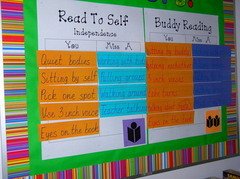
Independent and Buddy Reading Poster Template
One of the first activities at the beginning of the school year is teaching children how to read independently and read with a buddy. As a class we discuss and practice what reading should look like and what reading shouldn't look like. Once we've had time to practice these behaviors we make a list of things that "students" should be doing during this time and a list of things the "teacher" will be doing during this time. (These templates can be enlarged at Kinko's). For more information on teaching children how to read by themselves and with a buddy, I recommend reading "The Daily Five" by Gail Boushey and Joan Moser. This book will certainly support your teaching of strategies for reading comprehension.
Reading Process Poster Template
By enlarging the following template and laminating, you can write (with a dry-erase marker) important reading processes and applications for children to discuss and understand during and after a piece of literature is read.
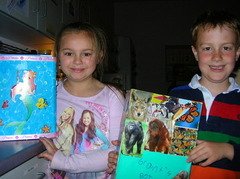
"Me Box" Parent Letter
Instead of purchasing book boxes (that are expensive and often break) for children to keep their books and writing samples in during the school year, I have children decorate a large cereal box with pictures of their families and things that are important to them. These boxes hold their favorite books that they can read and writing samples they want to share when special visitors come to our classroom. Children take pride in taking care of their "Me Box" and are excited when they can take them home at the end of the school year.
READ-O
As mentioned on the Reading Fluency Activities Page, students are encouraged to read each night at home with their families and keep track of the books they read. Students are given a paper clip to add to our Reading Web for each book they read. During winter break I like to introduce Read-O to my students. It provides children with different ways to read with their families. They can complete five-in-a-row or they may want to complete the whole chart.
Strategies for Reading Comprehension Template
Use the above template to display the strategies for reading comprehension in your classroom. Throughout the school year, place charts and pictures under each word to help students remember the strategies. (Some of the strategies have different names, which are available for you to choose).
COMPREHENSION CONNECTIONS
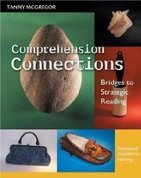 Many of the following activities and strategies for reading comprehension are ideas and extensions from the book, "Comprehension Connections" by Tanny McGregor. Although there are many great comprehension resources out there for parents and teachers, Steve and I have not been able to find a better one! Tanny provides tangible lessons that make abstract thinking concrete. If you haven't read it already, we highly recommend that you do! It is a great reference to learn about the strategies for reading comprehension!
Many of the following activities and strategies for reading comprehension are ideas and extensions from the book, "Comprehension Connections" by Tanny McGregor. Although there are many great comprehension resources out there for parents and teachers, Steve and I have not been able to find a better one! Tanny provides tangible lessons that make abstract thinking concrete. If you haven't read it already, we highly recommend that you do! It is a great reference to learn about the strategies for reading comprehension!
Click on the following link to access Tanny's Strategies for Reading Comprehension Bookmarks.
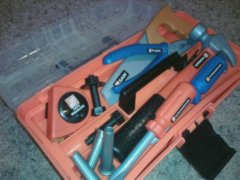
Metacognition Tool Kit
One day when a student was helping me screw the handle back on to a cabinet, he said, "These bolts are just like when we make connections when we are reading. These bolts connect to the handle to make it stay attached to the wood". We realized that the tools in Miss Appel's kit were very similar to the "tools" we use when we are reading. The above template demonstrates how we linked Miss Appel's tools to "Metacognition Tools". Toys "R" Us even has a "Home Depot Tool Kit" that contains all of these tools. This kit now remains at my reading table when students are reading. When they use one of the strategies for reading comprehension, we pull the tool out from our "Metacognition Tool Kit".
STRATEGIES FOR READING COMPREHENSION
Steve and I use the lessons found in Comprehension Connections by Tanny McGregor, Reading with Meaning by Debbie Miller, and 7 Keys to Comprehension by Susan Zimmerman and Chryse Hutchins to teach the strategies for reading comprehension.
METACOGNITION
*Introduce prior to the strategies for reading comprehension!
On the first day of school I share with my students my favorite word, "metacognition". I tell them "metacognition" is the most important word that they will learn all year long, but I am not going to tell them what it means until I am ready. (This gets them excited and eager to find out its meaning!) We count the letters in the word, we clap the syllables, and we trying segmenting the word. During the first week of school I send home Making Words With "Metacognition" to see how many words they can make using the letters in metacognition. After a few days, I break down and tell them it means to "think" and "read" at the same time. "That's it?" is usually the response I get. Yes, that is it!
Metacognition helps students understand the strategies for reading comprehension!
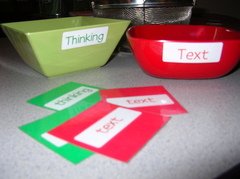
Reading Salad Labels
Since metacognition is being able to read and think at the same time, I demonstrate this by making a "reading salad". "Thinking" is represented by lettuce and the "text" is represented by tomatoes. When reading a book, I have two students stand on either side of me, each holding a green and red bowl. When I am reading the "text" a red card in placed in the red salad bowl. When I stop reading and "think" out loud, a green card is placed in the green salad bowl. This continues until I am finished reading. The cards are then dumped into a large salad bowl and mixed together to make a "reading salad". Print out the above link on Avery 8160 labels to create your own cards!
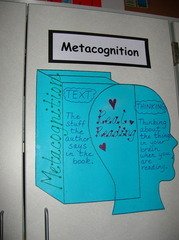
Metacognition Diagram
Like the "reading salad," the Metacognition Diagram is another way to explain metacognition. In her book Comprehension Connections, Tanny uses this Venn Diagram to help students understand what happens when you read and think at the same time. A great resource for teaching strategies for reading comprehension!
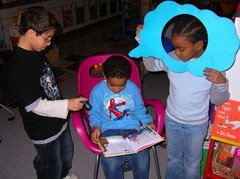
Thinking Bubble Template
By enlarging the above template and cutting out the center circle, one student becomes the "thinker" as the other student reads the "text" out loud. The thinker is encouraged to "yell out" their thinking as the other student is reading the book. My kids love this strategy for reading comprehension.
SCHEMA (BACKGROUND/PRIOR KNOWLEDGE)
*Introduce prior to the strategies for reading comprehension!
In 7 Keys to Comprehension, Zimmerman & Hutchins define schema (background knowledge) as the meaning you get from a piece of literature that is intertwined with the meaning you bring to it. A layering occurs, a weaving of past and present, an amalgam of old and new ideas and experiences. When you read, sometimes you activate your schema or you build upon it.
Schema helps students understand the strategies for reading comprehension!
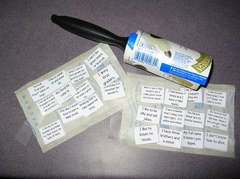
Miss Appel's Schema
Tanny demonstrates a great way to explain "schema" to young children...Lint rollers pick up stuff that comes in contact with it, because it's sticky (in much the same way that our brains "pick up stuff"). Everyone's schema is different because we've had different experiences in our lives. To explain this concept to my students, I share with them simple facts about myself that are "stuck on my brain". (Each year I base my schema upon the interests of my students and I try to share with them funny things to grab their attention...Click on the above link to see "Miss Appel's Schema").
A-Z Schema
Encourage children to use this chart to write down their schema about a certain topic by categorizing it by sound. For example, if the topic is "The Solar System" and the child knows the moon is white, they would write that in the "M" box. See if they can come up with schema for each box on this page!
Strategies for Reading Comprehension
MAKING CONNECTIONS
Children make personal connections with the text by using their schema. There are three main types of connections we can make during reading:
Making Connections: Story Impression
Help children make connections between words while making predictions about the text. Before reading, pick a handful of words that children will encounter. Write these words (in order they are located in the book) under "Story Chain". Have them read the first two words and think how they are connected. Under "Story Prediction," have them write words or draw pictures to describe the connection. Next, have them connect the second and third word and write words or draw a picture to describe the connection. This continues until all of the words have been "connected". This is a great vocabulary AND comprehension activity!
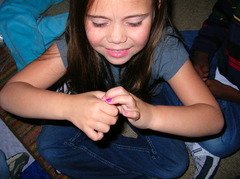
Making Connections
Children are eager to share their connections with those around them. Once one child shares, another one is likely to follow. When my students want to share their connection with the class, they interlock their thumbs and index fingers to show that they have something important they would like to share.
Hit the Books
One of our favorite exercises in teaching young children to make connections is browsing and selecting five books that they've never read and would likely never select. That's the key; pick up a book they never noticed before. Have children take some time to look through them. (They don't have to read every page of each book). But get a sense of what the book is about...Look for connections to school or life.
Inspiration Boards
Select an empty bulletin board and turn it into an inspiration board. Each time you find something compelling; a photo, a page of a magazine, a piece of fabric...tack it to the board. Before long, students will start seeing connections between the images that will expand your work.
Making Connections and Thinking About Connections
These two documents are pretty much the same. Students can draw pictures or write words to show their connections with text. When they are finished, I encourage them to share their connection with a buddy. These are also great to send home so that children can share their connections with their families!
Strategies for Reading Comprehension
CREATING MENTAL IMAGES (VISUALIZING)
This strategy involves the ability of readers to make mental images of a text as a way to understand processes or events they encounter during reading. This ability can be an indication that a reader understands the text.
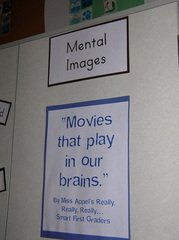
Creating Mental Images
I typically introduce "mental images" as one of the first strategies for reading comprehension at the beginning of the school year. During this time is also when I read aloud the series of Mercy Watson books by Kate DiCamillo (there are now five books). I read the first book in one sitting, "Mercy Watson Goes for a Ride" without sharing the colorful, funny illustrations...I even completely cover up the outside of the book so they have no idea what Mercy looks like! I tell my students that after the book is finished, they will create a portrait of how they picture Mercy to look. We share these pictures and then "uncover" the book to find out that Mercy is not a child, but a pig! (These drawings help students notice that mental images often look different from person to person!)
Adapting Mental Images
As we read and listen to stories and poems, are mental images can change. We don't always just have one mental image! In fact, good readers who are able to visualize when they are reading are able to recall what they read better than readers who don't visualize when they are reading. I use this template to demonstrate how my mental image can change by drawing pictures to match what I "see in my brain".
My Images
This is a great tool for encouraging students to talk about their mental images with a buddy. Have students draw or write words in the left-hand column to show their mental image. Give them time to share this mental image with a buddy and talk about it. Once they are finished, have them draw or write words in the right-hand column to show how their mental images changed after having a conversation with someone.
Recording Mental Images
In the middle of the year when we read "Charlie and the Chocolate Factory," we keep a special folder with our most vivid mental images for each chapter of the book. Each night students take home these folders to share with their families to retell and share what we read in class. After we finish reading the book, we watch the movie to see how our mental images compare to what we see on TV.
Strategies for Reading Comprehension
QUESTIONING
This strategy involves readers asking themselves questions throughout the reading of text. The ability of readers to ask themselves relevant questions as they read is especially valuable in helping them to integrate information, identify main ideas, and summarize information. Asking the right questions allows good readers to focus on the most important information in a text.
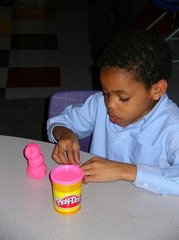
Play-Doh Questioning
I like to introduce "questioning" to my students by giving them a small container of Play-Doh. When they are at their seats I tell them to "construct something". I don't give them any other directions. In a five minute period, I write down on a large chart paper the questions they are asking. (If a student directs a question to me, I simply shrug my shoulders). Next, I tell them to add something to their creation (as I write down what they are saying). Once I have generated a plethora of questions, I tell them to put their Play-Doh away and take a look at some of the things they said. I explain that good readers ask themselves questions (just like they did when they were given the Play-Doh with out any directions) to help them become better readers.
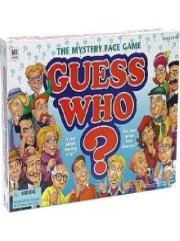
"Guess Who?" Game
Another great way to introduce this strategy is to play the game, "Guess Who?" In this game, each player is given a person (on a card) that the other player must figure out by eliminating other people (on other cards). The player who is able to ask appropriate questions has a better chance of winning the game...Just like people who ask good questions when they are reading have a better chance of comprehending the text!
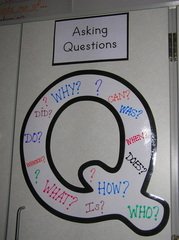
"Q" Question Template
By enlarging the above template and placing it in a prominent area of the classroom, you can help students generate a list of "question" words they may ask themselves when reading. Most of the time our questions begin with, "who, what, when, why, or where" but there are many words that we can use to ask questions...We write these down on our "Q" Chart to illustrate some of our strategies for reading comprehension!
Before, During, & After
This template can be enlarged, laminated, and displayed in the classroom. During a read aloud the teacher and students can write their questions on Post-Its and place on the chart.
Strategies for Reading Comprehension
INFERRING
Authors do not always provide complete descriptions of, or explicit information about a topic, setting, character, or event. However, they often provide clues that readers can use to “read between the lines”—by making inferences that combine information in the text with their schema.
Making Inferences
Each year my students learn quickly that a certain teacher likes to borrow materials from our room without asking. Every once in a while that teacher will return those materials and my kids say, "We've been looking all over the room for that!" By the middle of the year when we can't find something we know that Mr. Griffin probably has it in his room. We didn't see him take it and he didn't ask to borrow it...but we JUST KNOW it was him!
Inferring Song
Songs to familiar tunes can teach children reading strategies. This "Inferring Song Tune" can be sung to "My Bonnie Lies Over the Ocean".
Inferring Equation
As stated in Comprehension Connections, children infer all of the time, but that doesn't mean they know how to infer with text. When difficult text gets in the way, inferring can become drudgery. The explicit teaching of inferring is one of the most important things we can give our students. The above equation can be used with students in your classroom.
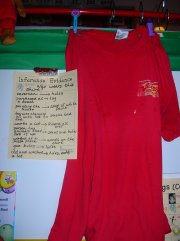
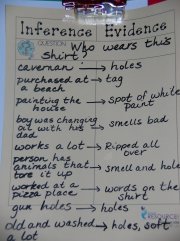
Inference Chart
This old discolored t-shirt (with many holes and paint stains) is a great way to help students infer and support with evidence. The question, "Who Wears this Shirt?" is posed at the beginning of the lesson. Using the template from above, I write my students' responses under "Inference". Then I link their inferences with all of the evidence with arrows. For example, one student said the person must have a lot of wild animals in their home (inference) because there are so many holes all over it (evidence). This activity can be done with many things you'd find in your home!
Reading Between the Lines
Inferring is very much like making a prediction, however inferring must be supported with evidence. Once a question is generated, students write down what they know in their brain (schema) and what they know from the book (evidence). Students use their schema and evidence to form an inference.
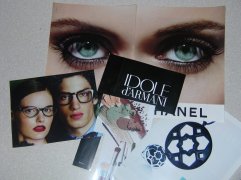
Magazine Clippings
Thinkers use every clue available to make sense of their world. A great way to do this is to dust off the old stack of magazines you have at home. Tear out advertisements that might seem interesting to children. Cut or over up words or pictures that would force the viewer to infer.
Songs to Teach Inferring
For a different approach to teaching inferring, download songs for children to listen to. Below are some suggestions of songs that work really well.
Song
Artist
Cat’s in the Cradle
Harry Chapin
The Climb
Miley Cyrus
The Luckiest
Ben Folds
Daniel
Elton John
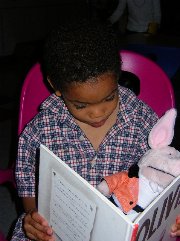
Olivia Books
Olivia is a high-energy pig who wears everyone out! Ian Falconer's "Olivia" series provides children many opportunities to make inferences through the humorous jokes and illustrations that even adults can enjoy.
Into the Book
"Into the Book" website provides many great resources for teaching comprehension. These resources are based upon many of the comprehension books that we recommend for parents and teachers. The following are some of our favorite picks for teaching inferring.
Strategies for Reading Comprehension
EVALUATING (DETERMINING IMPORTANCE)
Determining importance has to do with knowing why you’re reading and then making decisions about what information or ideas are most critical to understanding the overall meaning of the piece.
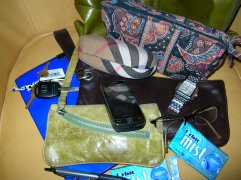
Determining Importance: Purse
I like to start out teaching this strategy by using something that is meaningful to me...My purse. When the kids are sitting down in a circle, I dump everything out that's in it. We discuss the contents for a few minutes and then I ask them out of all this "stuff"...What's most important? What are the 3 most important items that I MUST have in this purse? After some discussion, we will talk about the things that I MIGHT need to have in my purse (and why). We end by talking about the contents in my purse that are "just there". We usually reach the conclusion that Miss Appel has a lot of unnecessary items in her purse that she carries around...Her purse could be lighter on her shoulder if she'd clean it out and only keep what's important. Reading is much the same way. It's not possible to remember everything that we read...Rather, we need to learn how to determine what's important and what's not important.
Determining Importance: 20 Words
As students are reading a book or passage (or as a teacher is reading) have them right down the 20 most important words they think are important in understanding what was just read. (For young children, writing 10 words would work best). Have students work with a buddy to see if any of their words were similar.
Strategies for Reading Comprehension
SYNTHESIZING
Synthesizing is closely linked to evaluating. Basically, as we identify what’s important, we interweave our thoughts to form a comprehensive perspective to make the whole greater than just the sum of the parts.
Before I introduce the word "synthesize" to my students, I give them a dry-erase board and marker when I am reading aloud to them. I tell them to draw or write whatever pops into their head. When I find a student who erases to write/draw something new, I stop reading aloud. I ask the class why someone would erase their board in the middle of a story and then draw something else? I probe them until someone says, "Because my thinking changed".
Synthesizer
Tanny provides many great ways to introduce and explain "synthesizing" to children. My favorite way is by borrowing an electronic keyboard (synthesizer) from the music teacher. We play simple sounds on the keyboard (I give students each time to practice hitting the keys). These simple sounds can be combined to make more complex variations, much like how your thinking combines to make more complex thoughts when you are reading.
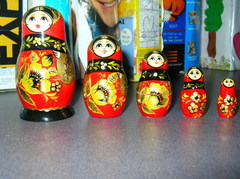
Nesting Dolls
When I discuss this strategy for reading comprehension, I place Nesting Dolls so that they are in order from largest to smallest. The students are asked how these dolls are like their thinking. By the end of the year, my first grade students understand that their thinking starts off small and gets bigger as they learn new information. They know that sometimes their thinking is a bunch of small thoughts that form bigger thoughts.
Synthesizing Target
The nesting dolls can demonstrate how sometimes our thinking can change when we are reading. Using the above template, have students draw or write words in the middle circle to show what they are thinking. Each time their thinking changes, it's written (or drawn) in the next ring. (This target only has two circles in which I like to use when I am first teaching this strategy). When your child understands this concept you can use the template below to add more target circles.
Synthesizing
This template is used much like "Adapting Mental Images" in which the student can write or draw pictures to show how their thinking changes when they are reading.
Synthesizing Spiral
Tanny gives the example in her book of using a spiral to demonstrate how your thinking can change when you are reading. Your initial response is written in the center of the spiral and curls around as your thinking changes.
Be sure to check back often for updates to our Strategies for Reading Comprehension Page





